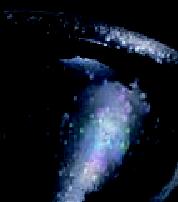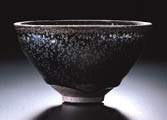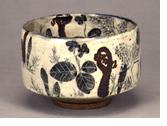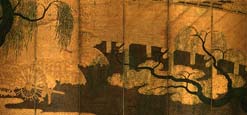Yohen Tenmoku:
a priceless treasure
gleaming in azure.

Even
at present, when science is making such momentous technological advances,
there is still no way to reproduce a Yohen Tenmoku tea bowl. A pattern of
star-bursts sparkle from the black glaze of this tea bowl and within each
star can be seen the navy-blue color of glistening mother-of-pearl. Gazing
long enough at its surface, it comes to resemble an expanse of stars drifting
across the heavens on a summer's night. Seeing the glimmer that these stars
emit when light shifts across them is akin to a mystical experience.
In the Kamakura period (12th -14th century
AD), the Japanese Zen priest Yosai traveled to China to study Buddhism and,
when he returned, brought with him both the Chinese custom of drinking tea
and a new variety of tea to the Zen temples of Japan. During the following
Muromachi period, tea clubs with tea and tea utensils imported from China
became the rage and the most highly sought after tea ceremony objects were
the Tenmoku tea bowls and the most unique and best-known among them were the
Yohen, or spotted, tea bowls.
Only four great Yohen Tenmoku tea bowls
have come down to us. Three of these masterpieces are designated National
Treasures. The fourth is found in the MIHO MUSEUM's collection and its existence
was not widely known until fairly recently. While the other three bowls have
their star-burst spots formed from several joined dots of crystal, the crystals
dots of the MIHO MUSEUM's bowl appear separately. In the other three works,
the crystalline inlays are limited to a few select places, but in the MIHO
MUSEUM's bowl each of the spots of crystalline cover the bowl to create a
unique, glimmering effect. Although the MIHO MUSEUM's bowl does not have the
large star-burst patterns of the other ware of its type, the mother-of-pearl
bursts that shift in color from navy-blue to azure with the changing light
lend it an even more lustrous shimmer against its gleaming black glaze.
The gently shaped, wheel-ground rim of the bowl's
mouth, which has been pressed down once, displays an amazing degree of precision
and the fact that the rim is undecorated neatly completes the work. The bowl,
transmitted through the Maeda Toshitsune family, has now been designated an
Important Cultural Property. The Yohen bowls all originated from the Jian
kilns in the Fujien Province of China, and all were fired in the Song Dynasty
or at some earlier period. It would be no exaggeration to say that Yohen Ware
is the epitome of the ceramic style of China at this time and of this ware
the Tenmoku pieces are the most exquisite. It is also clear that the only
extant examples of the style exist solely in Japan. In addition, because the
adjustment of the fire in the kilns was left to chance when these bowls were
made, their final appearance was impossible to predict. Yohen Tenmoku tea
bowls could be thought of as sacred utensils created by the
hand of God.
 Yohen Tenmoku Tea Bowl
Yohen Tenmoku Tea Bowl
China, Song Dynasty,
11th - 12th century
Height 6.5 - 6.6 cm. Mouth diameter 11.8 - 12.1 cm. Foot diameter 3.9 cm.

Carring Lunch Box with Cherry Blossoms and Maple Leaves Design
Edo period, 18th-19th century AD by Yamamoto Shunsho
This flower-decorated meal-box is a good example of convenient and portable objects that were produced in the Sageju style. The cloud brocade pattern of its lacquered finish includes both cherry blossoms and autumn leaves, which indicate that the box was suitable for outings both in Spring and Fall.
 Tea Bowl with Spring Grasses Design, Kenzan ware
Tea Bowl with Spring Grasses Design, Kenzan wareEdo period, 18th century AD
On this tea bowl scenes of the eventual arrival of visitors at a snow-bound mountain village are tastefully decorated with a karakusa vining floral pattern. Through the affectionate rendering of bracken, consecrated rice, horsetail, and other wild plants, one can plainly see the fondness that Kenzan had for nature.
 Seated Juichimen- Kannon
Seated Juichimen- KannonSeated Deity in the form of Buddhist Monk
Heian period, 12th century AD
The iconographic form that these figures take is based on depictions of small Buddhas. They represent Shinto deities that appear in fields and on hills. Within what, at first, seems a rather simply carved work minute detail can be found. The overall impression created is one of two large figures sitting serenely in complete silence.
 Fragment of Poem Anthology Shinkokinwakashu by the Emperor Fushimi
Fragment of Poem Anthology Shinkokinwakashu by the Emperor FushimiKamakura period, 13 - 14th century AD
This artistic expression of waka poetry and calligraphy by Emperor Fushimi is an example of what came to be called "Fushimi-style" calligraphy. The elegant traces of Fushimi's brush reveal his careful study of "Sanseki(three master calligraphists of mid Heian period,Ono Michikaze, Fujiwara no Sukemasa, and Fujiwara no Yukinari). The piece is all the more exquisite for the aged paper on which it was written, giving it a calm, soft, cloud-like texture.
 Fragment
of the "Frolicking Animals and Human Figures" Scroll
Fragment
of the "Frolicking Animals and Human Figures" ScrollKamakura period, 13th century AD
This section of the "Frolicking Animals and Human Figures" scroll from the collection of the Kozanji Temple in Kyoto depicts human and human-like animal characters shown in an affectionate and humorous light. In this section, two humans practice sumo as two others are mounted on horses. The desperate plight of one of the wrestlers suspended in mid-air adds a decisively comical touch to the work.
 Folding Screen with Willow, Bridge and Waterwheel Design
Folding Screen with Willow, Bridge and Waterwheel DesignMomoyama - Edo periods, 17th century AD
This dazzling screen is the very image of the Momoyama period. Based on a waka poem about the landscape around Uji that the artist had read, the treatment of a riverbank scene intersected by a large bridge gives it a unique design scheme.